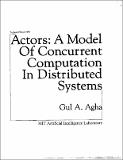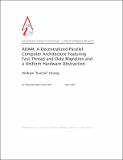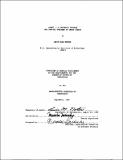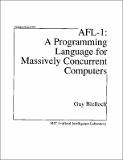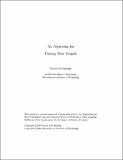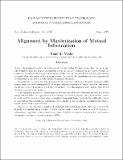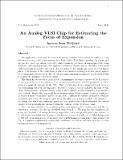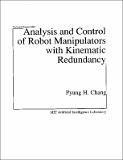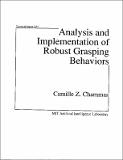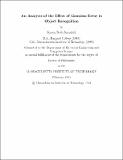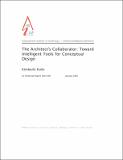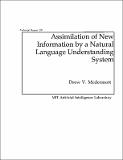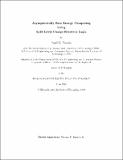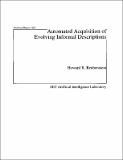Browsing AI Technical Reports (1964 - 2004) by Title
Now showing items 1-20 of 327
-
2D-3D Rigid-Body Registration of X-Ray Fluoroscopy and CT Images
(2001-08-01)The registration of pre-operative volumetric datasets to intra- operative two-dimensional images provides an improved way of verifying patient position and medical instrument loca- tion. In applications from orthopedics ... -
An Accountable Source-To-Source Transformation System
(1981-06-01)Though one is led to believe that program transformation systems which perform source-to-source transformations enable the user to understand and appreciate the resulting source program, this is not always the case. ... -
Achieving Real-Time Mode Estimation through Offline Compilation
(2002-10-22)As exploration of our solar system and outerspace move into the future, spacecraft are being developed to venture on increasingly challenging missions with bold objectives. The spacecraft tasked with completing these ... -
ACTORS: A Model of Concurrent Computation in Distributed Systems
(1985-06-01)A foundational model of concurrency is developed in this thesis. We examine issues in the design of parallel systems and show why the actor model is suitable for exploiting large-scale parallelism. Concurrency in actors ... -
ADAM: A Decentralized Parallel Computer Architecture Featuring Fast Thread and Data Migration and a Uniform Hardware Abstraction
(2002-06-01)The furious pace of Moore's Law is driving computer architecture into a realm where the the speed of light is the dominant factor in system latencies. The number of clock cycles to span a chip are increasing, while the ... -
ADEPT: A Heuristic Program for Proving Theorems of Group Theory
(1966-09-01)A computer program, named ADEPT (A Distinctly Empirical Prover of Theorems), has been written which proves theorems taken from the abstract theory of groups. Its operation is basically heuristic, incorporating many ... -
AFL-1: A Programming Language for Massively Concurrent Computers
(1986-11-01)Computational models are arising is which programs are constructed by specifying large networks of very simple computational devices. Although such models can potentially make use of a massive amount of concurrency, ... -
An Algorithm for Parsing Flow Graphs
(1984-03-01)This report describes research about flow graphs - labeled, directed, acyclic graphs which abstract representations used in a variety of Artificial Intelligence applications. Flow graphs may be derived from flow ... -
Alignment by Maximization of Mutual Information
(1995-03-01)A new information-theoretic approach is presented for finding the pose of an object in an image. The technique does not require information about the surface properties of the object, besides its shape, and is robust ... -
AMAR: A Computational Model of Autosegmental Phonology
(1993-10-01)This report describes a computational system with which phonologists may describe a natural language in terms of autosegmental phonology, currently the most advanced theory pertaining to the sound systems of human ... -
An Analog VLSI Chip for Estimating the Focus of Expansion
(1996-08-21)For applications involving the control of moving vehicles, the recovery of relative motion between a camera and its environment is of high utility. This thesis describes the design and testing of a real-time analog ... -
Analysis and Control of Robot Manipulators with Kinematic Redundancy
(1987-05-01)A closed-form solution formula for the kinematic control of manipulators with redundancy is derived, using the Lagrangian multiplier method. Differential relationship equivalent to the Resolved Motion Method has been ... -
Analysis and Implementation of Robust Grasping Behaviors
(1990-05-01)This thesis addresses the problem of developing automatic grasping capabilities for robotic hands. Using a 2-jointed and a 4-jointed nmodel of the hand, we establish the geometric conditions necessary for achieving ... -
An Analysis of the Effect of Gaussian Error in Object Recognition
(1994-02-01)Object recognition is complicated by clutter, occlusion, and sensor error. Since pose hypotheses are based on image feature locations, these effects can lead to false negatives and positives. In a typical recognition ... -
The Architect's Collaborator: Toward Intelligent Tools for Conceptual Design
(2001-01-01)In early stages of architectural design, as in other design domains, the language used is often very abstract. In architectural design, for example, architects and their clients use experiential terms such as "private" ... -
ARLO: Another Representation Language Offer
(1986-10-01)This paper describes ARLO, a representation language loosely modelled after Greiner and Lenant's RLL-1. ARLO is a structure-based representation language for describing structure-based representation languages, including ... -
Assimilation of New Information by a Natural Language Understanding System
(1974-02-01)This work describes a program, called TOPLE, which uses a procedural model of the world to understand simple declarative sentences. It accepts sentences in a modified predicate calculus symbolism, and uses plausible ... -
Asymptotically Zero Energy Computing Using Split-Level Charge Recovery Logic
(1994-06-01)The dynamic power requirement of CMOS circuits is rapidly becoming a major concern in the design of personal information systems and large computers. In this work we present a number of new CMOS logic families, Charge ... -
Attentional Selection in Object Recognition
(1993-01-01)A key problem in object recognition is selection, namely, the problem of identifying regions in an image within which to start the recognition process, ideally by isolating regions that are likely to come from a single ... -
Automated Acquisition of Evolving Informal Descriptions
(1990-06-01)The Listener is an automated system that unintrusively performs knowledge acquisition from informal input. The Listener develops a coherent internal representation of a description from an initial set of disorganized, ...




